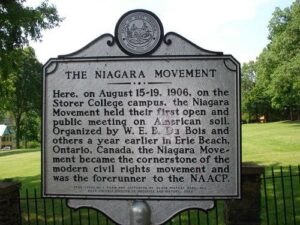Fighting For Our Rights: The Niagara Movement.
The Niagara Movement demanded equal economic, educational, as well as voting opportunities for both Black men and women. Members of the Niagara Movement had sent a powerful message to the entire country through their condemnation of racial discrimination and their call for an end to segregation. This moment was a civil rights group organized by W.E.B. Du Bois as well as William Monre Trotter in 1905. After being denied admittance to hotels in Buffalo, New York, the group of twenty-nine business owners, teachers, and clergy who comprised the initial meeting gathered at Niagara Falls, Ontario (Canada). The main principle behind the entire moment was largely in opposition to Booker T. Washington’s philosophy of accommodation.
Booker T. Washington was an educator, reformer and the most influential black leader of his time. He lived from 1856-1915. Preached a philosophy of self-help, racial solidarity and accommodation. He urged Blacks to accept the discrimination they were experiencing, and to concentrate on elevating themselves through hard work, and material porosity. Nonetheless, many Blacks had disagreed with him tremendously.
W.E.B Du Bois, scholar as well as an activist for racial equality. He believed the educated African American’s must use their education and training to challenge inequality. He was also, known to be the best known spokesperson of African American rights during the first half of the twentieth century.
Of Du Bois And Diaspora The Challenge of African American Studies, Michael A. Gomez focuses on double consciousness. The internal conflict experienced by subordinates or a colonized people in an oppressive society. Double consciousness, African Americans struggle with the dilemma of being both African and American, battling nationality and race as they understand, and start finding their purpose in history as well in modern society. “He would not bleach his Negro soul in a flood of White Americans… He simply wishes to make it possible for a man to be a both a Negro and an American, without being cursed and spit upon by his fellows, without the doors of Opportunity closed roughly in his face.” (Gomez, 176) that was said by W.E.B Du Bois, who is trying to claim the Black man will not change for America, nor will America change for it. Blacks wish to have the same opportunity the white man has, the same privilege.
In the late 1800’s Booker T. Washington believed that Blacks should gain their equality to whites through establishing a solid labor force, and accommodating the existing belief of the government’s idea of segregation and inequality. In an effort to overcome Washington’s ideals, the Niagara movement was forced. This movement was first organized in July 11 through 13, 1905 organized in order to oppose racial segregation and disenfranchised. It opposed what it’s members believed were policies of accommodations as well as conciliation promoted by African-American leaders such as Booker T. Washington. The moment served as a tool to help the African-American population at the time, to move forward and away from the suppression that they were being coated with by the racist white community.
The ideals that were created by Washington would have not proven effective in the latter years opposed to those enforced by the leaders of the Niagara Movement. This submissive effort created by Washington to move on, would have left the Blacks populated subjects to more abuse, it had been proven before by others who were in similar situations that passivity was not a route they should in fact should’ve taken. It only held those who had tried to be thrown into jail, prosecuted, beaten, or even killed.
The leaders of The Niagara Movement showed that it took force as well as determination to get what they in fact wanted, the type of change that they wanted to see. The movement itself had proved, just the effort of these members who soon became part of it, had opened doors to many others to attempt the abolition of segregation along with the Jim Crow Laws.
The Niagara Movement attempted to bring about legal changes, addressing the issues of crime, economics, religion, health, as well as education. Despite its impressive beginning, the movement did not last as long as people expected, but it did in fact leave a lasting impression on others. The movement stood out compared to the others that were happening at the same time, due to its powerful unequivocal demand for equal rights. Nonetheless, this movement had many Black were one step closer to what they should’ve never fought for, which was equality.
Booker T. Washington and W. E. B. Du Bois


Work Cited
Gomez, Michael A. “Of Du Bois And Diaspora The Challenge of African American Studies.” Journal Of Black Studies, vol. 30, no. Nov. 2004, 2004, pp. 175 – 194.



